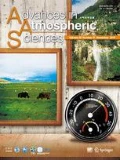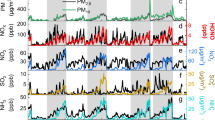Abstract
The Weather Research and Forecasting/Chemistry model (WRF-Chem) was updated by including photoexcited nitrogen dioxide (NO2) molecules, heterogeneous reactions on aerosol surfaces, and direct emissions of nitrous acid (HONO) in the Carbon-Bond Mechanism Z (CBM-Z). Five simulations were conducted to assess the effects of each new component and the three additional HONO sources on concentrations of major chemical components. We calculated percentage changes of major aerosol components and concentration ratios of gas NO y (NO yg) to NO y and particulate nitrates (NO −3 ) to NO y due to the three additional HONO sources in the North China Plain in August of 2007. Our results indicate that when the three additional HONO sources are included, WRF-Chem can reasonably reproduce the HONO observations. Heterogeneous reactions on aerosol surfaces are a key contributor to concentrations of HONO, nitrates (NO −3 ), ammonium (NH +4 ), and PM2.5 (concentration of particulate matter of ⩽2.5 μm in the ambient air) across the North China Plain. The three additional HONO sources produced a ∼5%–20% increase in monthly mean daytime concentration ratios of NO −3 /NO y , a ∼15%–52% increase in maximum hourly mean concentration ratios of NO −3 /NO y , and a ∼10%–50% increase in monthly mean concentrations of NO −3 and NH t+4 across large areas of the North China Plain. For the Bohai Bay, the largest hourly increases of NO −3 exceeded 90%, of NH t+4 exceeded 80%, and of PM2.5 exceeded 40%, due to the three additional HONO sources. This implies that the three additional HONO sources can aggravate regional air pollution, further impair visibility, and enhance the incidence of haze in some industrialized regions with high emissions of NO x and particulate matter under favorable meteorological conditions.
Similar content being viewed by others
References
An, J., W. Zhang, and Y. Qu, 2009: Impacts of a strong cold front on concentrations of HONO, HCHO, O3, and NO2 in the heavy traffic urban area of Beijing. Atmos. Environ., 43, 3454–3459.
An, J., Y. Li, F. Wang, and P. Xie, 2011: Impacts of photoexcited NO2 chemistry and heterogeneous reactions on concentrations of O3 and NOy in Beijing, Tianjin and Hebei Province of China. Air Quality-Models and Applications, N. Mazzeo, Ed., InTech, 197–210.
Aumont, B., F. Chervier, and S. Laval, 2003: Contribution of HONO sources to the NOx/HOx/O3 chemistry in the polluted boundary layer. Atmos. Environ., 37, 487–498.
Bian, H., and C. S. Zender, 2003: Mineral dust and global tropospheric chemistry: Relative roles of photolysis and heterogeneous uptake. J. Geophys. Res., 108(4672), doi: 10.1029/2003JD003143.
Cleemput, O. V., and A. H. Samater, 1996: Nitrite in soils: accumulation and role in the formation of gaseous N compounds. Fertilizer Research, 45, 81–89.
Crowley, J. N., and S. A. Carl, 1997: OH formation in the photoexcitation of NO2 beyond the dissociation threshold in the presence of water vapor. J. Phys. Chem., 101, 4178–4184.
Dentener, F. J., and P. J. Crutzen, 1993: Reaction of N2O5 on tropospheric aerosols impact on the global distributions of NOx, O3, and OH. J. Geophys. Res., 98(D4), 7149–7163.
Emmons, L. K., and Coauthors, 2010: Description and evaluation of the Model for Ozone and Related chemical Tracers, version 4 (MOZART-4). Geoscientific Model Development, 3, 43–67.
Ensberg J. J., M. Carreras-Sospedra, and D. Dabdub, 2010: Impacts of electronically photo-excited NO2 on air pollution in the South Coast Air Basin of California. Atmospheric Chemistry and Physics, 10, 1171–1181.
Fast, J. D., W. I. Gustafson, R. C. Easter, R. A. Zaveri, J. C. Barnard, E. G. Chapman, G. A. Grell, and S. E. Peckham, 2006: Evolution of ozone, particulates, and aerosol direct radiative forcing in the vicinity of Houston using a fully coupled meteorology-chemistry-aerosol model. J. Geophys. Res., 111(D21305), doi: 10.1029/2005JD006721.
Foley, K. M., and Coauthors, 2009: Incremental testing of the community multiscale air quality (CMAQ) modeling system version 4.7. Geoscientific Model Development, 3, 205–226.
Grell, G. A., S. E. Peckham, R. Schmitz, S. A. Mckeen, G. Frost, W. C. Skamarock, and B. Eder, 2005: Fully coupled “online” chemistry within the WRF model. Atmos. Environ., 39, 6957–6975.
Guenther, A., P. Zimmerman, P. C. Harley, R. K. Monson, and R. Fall, 1993: Isoprene and monoterpene emission rate variability: Model evaluations and sensitivity analyses. J. Geophys. Res., 98, 12609–12617.
Gutzwiller, L., F. Arens, U. Baltensperger, H. W. Gaggeler, and M. Ammann, 2002: Significance of semivolatile diesel exhaust organics for secondary HONO formation. Environ. Sci. Technol., 36, 677–682.
Jacob, D. J., 2000: Heterogeneous chemistry and tropospheric ozone. Atmos. Environ., 34, 2131–2159.
Kurtenbach, R., and Coauthors, 2001: Investigations of emissions and heterogeneous formation of HONO in a road traffic tunnel. Atmos. Environ., 35, 3385–3394.
Li, S., J. Matthews, and A. Sinha, 2008: Atmospheric hydroxyl radical production from electronically excited NO2 and H2O. Science, 319, 1657–1660.
Li, G., W. Lei, M. Zavala, R. Volkamer, S. Dusanter, P. Stevens, and L. T. Molina, 2010: Impacts of HONO sources on the photochemistry in Mexico City during the MCMA-2006/MILAGO Campaign. Atmospheric Chemistry and Physics, 10(14), 6551–6567.
Li, Y., J. An, M. Min, W. Zhang, F. Wang, and P. Xie, 2011: Impacts of HONO sources on the air quality in Beijing, Tianjin and Hebei Province of China. Atmos. Environ., 45(27), 4735–4744.
Qin, M., and Coauthors, 2009: An observational study of the HONO-NO2 coupling at an urban site in Guangzhou City, South China. Atmos. Environ., 43, 5731–5742.
Sarwar, G., S. J. Roselle, R. Mathur, W. Appel, R. L. Dennis, and B. Vogel, 2008: A comparison of CMAQ HONO predictions with observations from the Northeast Oxidant and Particle Study. Atmos. Environ., 42, 5760–5770.
Sarwar, G., R. W. Pinder, K. W. Appel, R. Mathur, and A. G. Carlton, 2009: Examination of the impact of photoexcited NO2 chemistry on regional air quality. Atmos. Environ., 43, 6383–6387.
Simpson, D., A. Guenther, C. N. Hewitt, and R. Steinbrecher, 1995: Biogenic emissions in Europe 1. Estimates and uncertainties. J. Geophys. Res., 100, 22875–22890.
Streets, D. G., and Coauthors, 2003: An inventory of gaseous and primary aerosol emissions in Asia in the year 2000. J. Geophys. Res., 108(D21), 8809, doi: 10.1029/2002JD003093.
Su, H., and Coauthors, 2008: Nitrous acid (HONO) and its daytime sources at a rural site during the 2004 PRIDE-PRD experiment in China. J. Geophys. Res., 113(D14312), doi: 10.1029/2007jd009060.
Su, H., and Coauthors, 2011: Soil nitrite as a source of atmospheric HONO and OH radicals. Science, 333, 1616–1618.
Thornton, J., and J. P. D. Abbatt, 2005: Measurements of HO2 uptake to aqueous aerosol: Mass accommodation coefficients and net reactive loss. J. Geophys. Res., 110(D08309), doi: 10.1029/2004jd005402.
Wennberg, P. O., and D. Dabdub, 2008: Rethinking ozone production. Science, 319, 1624–1625.
Yu, Y., B. Galle, A. Panday A, E. Hodson, R. Prinn, and S. Wang, 2009: Observations of high rates of NO2-HONO conversion in the nocturnal atmospheric boundary layer in Kathmandu, Nepal. Atmospheric Chemistry and Physics, 9, 6401–6415.
Zaveri, R. A., R. C. Easter, J. D. Fast, and L. K. Peters, 2008: Model for Simulating Aerosol Interac tions and Chemistry (MOSAIC). J. Geophys. Res., 113(D13204), doi: 10.1029/2007JD008782.
Zhang, Q., and Coauthors, 2009: Asian emissions in 2006 for the NASA INTEX-B mission. Atmospheric Chemistry and Physics, 9, 5131–5153.
Zhang, Y., T. Wang, Z. Hu, and C. Xu, 2004: Temporal variety and spatial distribution of dry deposition velocities of typical air pollutants over different landuse types. Climatic and Environmental Research, 9(4), 591–604. (in Chinese)
Zhu, Y., W. Liu, P. Xie, K. Dou, S. Liu, F. Si, S. Li, and M. Qin, 2009: Observations of atmospheric HONO in summer of Beijing. Environmental Science, 30(6), 1567–1573. (in Chinese)
Ziemba, L. D., J. E. Dibb, R. J. Griffin, C. H. Anderson, S. I. Whitlow, B. L. Lefer, B. Rappenglück, and J. Flynn, 2010: HHeterogeneous conversion of nitric acid to nitrous acid on the surface of primary organic aerosol in an urban atmosphere. Atmos. Environ., 44(33), 4081–4089.
Author information
Authors and Affiliations
Corresponding author
Rights and permissions
About this article
Cite this article
An, J., Li, Y., Chen, Y. et al. Enhancements of major aerosol components due to additional HONO sources in the North China Plain and implications for visibility and haze. Adv. Atmos. Sci. 30, 57–66 (2013). https://doi.org/10.1007/s00376-012-2016-9
Received:
Revised:
Published:
Issue Date:
DOI: https://doi.org/10.1007/s00376-012-2016-9




